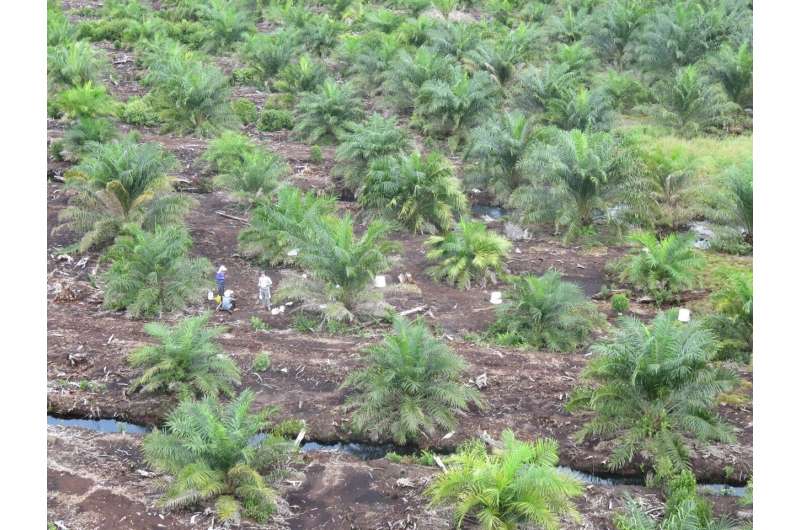Field investigation in an oil palm plantation next to the Klias Peat Swamp Field Centre, Sabah, Malaysia. Most peatlands in Borneo are drained and rich in nitrous oxide-producing microbes. Photo: Taavi Pae. Credit: Taavi Pae
Nitrous oxide (N2O) is a dangerous greenhouse gas, warms the climate and destroys the stratospheric ozone layer. Nitrous oxide is the intermediate and by-product of several processes of the nitrogen cycle conducted by soil microbes. While undisturbed wet peatlands do not emit much N2O, drained peatlands are substantial sources of nitrous oxide. A global study of peatlands led by geographers and microbiologists of the University of Tartu, Estonia, identified the microbes involved in nitrous oxide emissions from different peatland environments.
Genetic analysis of soil samples from all major peatland regions and types of the world revealed that high nitrous oxide emissions are associated with several microbial groups. Among those, nitrifying archaea and bacteria, denitrifiers, and ammonifiers (DNRA) emerged as important. In peatlands with high nitrous oxide production, all those microbial groups were abundant. Therefore, the more nitrous oxide-producing microbial groups are present in the soil, the more nitrous oxide the peatland emits.
Nitrous oxide is a nitrogen compound and thus part of the nitrogen cycle. Nitrification is a process where microbes consume ammonium (NH4) and dissolved oxygen (O2) from the soil, and produce nitrous oxide and eventually nitrate (NO3). This study distinguished between nitrifying bacteria and archaea. The latter are a more ancient group that thrives in more extreme environments. Nitrifying archaea showed the most significant correlation with nitrous oxide emissions among the microbes. During the study, a large amount of nitrifiers were found in both dry and wet peatlands. This is a sure sign of climate change that has temporarily drawn down the water table and introduced oxygen in wet peatlands.
Denitrification is a process where microbes, in the absence of dissolved oxygen, consume the oxygen from nitrate and produce nitrous oxide and eventually inert N2 nitrogen. Abundant denitrifiers were found during the study in both wet and dry peatlands. This shows that even the driest of peatlands experience seasonal floods or even have permanently wet aggregates. In conclusion, the results show complex mechanisms behind the nitrous oxide pollution. This calls for global attention. Microbes react rapidly to environmental change. It is difficult to stop them from producing nitrous oxide from highly available soil nitrogen compounds at favorable environmental conditions. One way to address the issue is to use nitrogen fertilizers wisely. Equally important is to combat climate change, especially the climatic drying and man-made drainage of peatlands.
The research was published in Nature Communications.
More information: Mohammad Bahram et al, Structure and function of the soil microbiome underlying N2O emissions from global wetlands, Nature Communications (2022). DOI: 10.1038/s41467-022-29161-3
Journal information: Nature Communications
Provided by Estonian Research Council
























